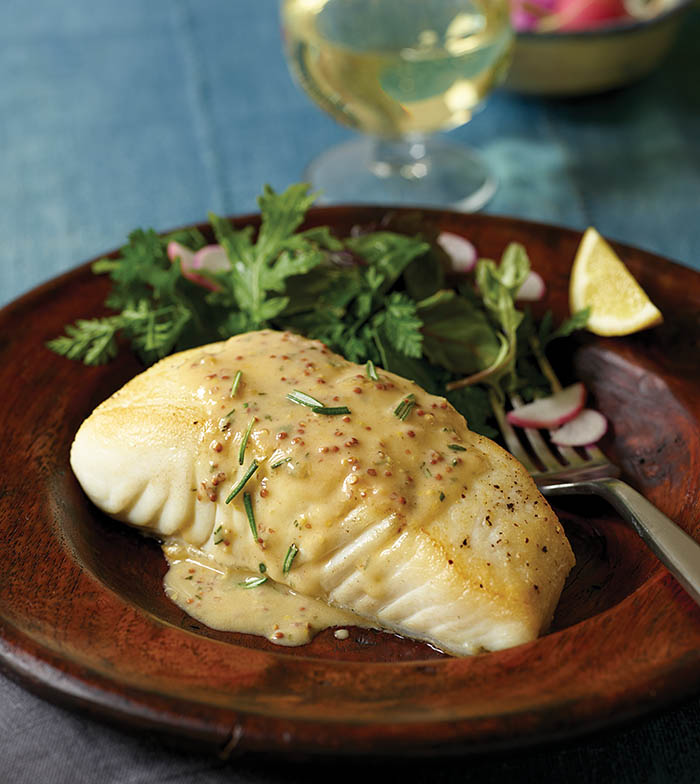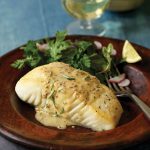
I’ve been serving variations of this dish for years, and it remains one of my favorites. Although halibut is a relatively mild fish, the firm texture makes it hearty enough to stand up to bold sauces. Keep in mind that halibut has a very small window between undercooked and overcooked. Do your best to cook it until the flakes are just loosening at the thickest point, then let it rest and allow the carry-over heat to finish it. It is too precious to serve dry. You can adjust the taste and texture of the sauce by adding or reducing the amount of butter. Sometimes I like this sauce coarse, robust, and thick, other times I want it silky and flowing.
— Susan Volland
 Excerpted from Searing Inspiration: Fast, Adaptable Entrées and Fresh Pan Sauces by Susan Volland, published by W. W. Norton & Company. © 2018 by Susan Volland. Photography © 2018 by Angie Norwood Browne.
Excerpted from Searing Inspiration: Fast, Adaptable Entrées and Fresh Pan Sauces by Susan Volland, published by W. W. Norton & Company. © 2018 by Susan Volland. Photography © 2018 by Angie Norwood Browne.
- 1 to 1-1/2 pounds (450 to 675 g) halibut fillets
- 2 to 3 tablespoons all-purpose or rice flour, for dredging (optional)
- Salt and finely ground black or white pepper
- 2 tablespoons (about) neutral oil or clarified butter
- 1/3 cup dry white wine such as Sauvignon Blanc or Pinot Gris, or extra-dry vermouth
- 1 tablespoon whole-grain mustard
- 2 teaspoons dijon mustard
- 2 teaspoons prepared horseradish
- 1 teaspoon finely chopped fresh rosemary
- 2 to 3 tablespoons cold unsalted butter cut into pats or small cubes (or substitute olive oil)
- lemon wedges for garnish
- Prep: Heat the oven to 425°F/220°C.
- The halibut can be cut into individual portions or left whole and served family-style, if it fits in the skillet. Pat dry and season generously with salt and pepper. Dredge the fish in the flour, if using, and pat off the excess.
- SEAR: Heat a large ovenproof skillet over medium-high heat. When it is hot, swirl in just enough oil to coat the bottom. Arrange the fillets in the pan so they are evenly spaced. They should sizzle the moment they hit the hot oil. (If there is not enough room in the pan for all of the pieces, sear them in batches, wiping the pan clean and starting with fresh oil as needed.) Sear the fillets until they are golden brown on the first side, about 3 minutes.
- Flip the fillets and put the pan in the oven. Fillets that are about 1 inch/2.5 cm will take 3 to 4 minutes in the oven; thicker fillets will take longer. Check for doneness: The flakes should be loose but the fish should remain very slightly translucent at the thickest point. The fillets will continue to cook slightly as they rest.
- The pan handle will be very hot, so be sure to use an oven mitt from this point on. Lift the fish out of the pan onto a clean platter or plates and keep warm while you make the sauce.
- SAUCE: Discard the cooking oil and analyze the pan residue. Remove any unappealing bits. Deglaze the pan with the white wine. Use a wooden spoon to soften and dissolve any brown residue on the bottom of the pan. Increase the temperature and simmer the wine until the aroma of raw alcohol has cooked off and the volume has reduced by half. Stir in the mustards, horseradish, rosemary, and any juices that have collected under the halibut and bring just to a simmer. Gradually stir in the butter, a few pieces at a time, until just melted (or add enough olive oil to make it saucy); do not boil after the butter has been added. Taste and adjust the seasoning with salt and pepper as necessary.
- Spoon just enough sauce over the fish to moisten it; serve the remainder alongside. Garnish the dish with lemon wedges and serve.


